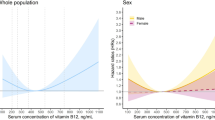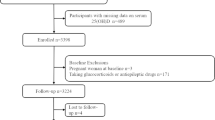Abstract
Purpose
Compared with people without diabetes, people with type 2 diabetes (T2D) are at higher risk of both subnormal vitamin C status and increased oxidative stress. We aimed to investigate the associations of serum vitamin C concentrations with all-cause and cause-specific mortality among adults with and without T2D.
Methods
The current analysis included 20,045 adults (2691 people with T2D and 17,354 without T2D) from the Third National Health and Nutrition Examination Survey (NHANES III) and NHANES 2003–2006. Cox proportional hazards regression models were applied to estimate hazard ratios (HRs) and 95% confidence intervals (CIs). Restricted cubic spline analyses were used to examine the dose–response relationship.
Results
After a median follow-up of 17.3 years, 5211 deaths were documented. Individuals with T2D had a lower level of serum vitamin C concentrations compared with those without T2D (the median value: 40.1 vs. 44.9 μmol/L). Furthermore, the dose–response relationship between serum vitamin C and mortality showed different patterns between participants with and without T2D. In individuals without T2D, there was a nonlinear association of serum vitamin C concentrations with all-cause, cancer, and CVD mortality, with the lowest risk around a serum vitamin C concentration of 48.0 μmol/L (all Poverall < 0.05, Pnonlinearity < 0.05). In contrast, among those with T2D in the similar concentration range, higher serum vitamin C levels (ranged from 0.46 to 116.26 μmol/L) were linearly associated with lower all-cause and cancer mortality (both Poverall < 0.05, Pnonlinearity > 0.05). Significant additive interaction was observed between diabetes status and serum vitamin C levels with regard to all-cause and cancer mortality (P < 0.001). In addition, C-reactive protein, gamma-glutamyl transpeptidase, and HbA1c explained 14.08, 8.96, and 5.60% of the association between serum vitamin C and all-cause mortality among individuals with T2D, respectively.
Conclusions
Higher serum vitamin C concentrations were significantly associated with lower risk of mortality in participants with T2D in a linear dose–response manner, while a nonlinear association was observed in participants without T2D, with an apparent threshold around 48.0 μmol/L. These findings suggest that the optimal vitamin C requirement may differ in individuals with and without T2D.

Similar content being viewed by others
Data availability
Some or all data generated or analyzed during this study are included in this published article or in the data repositories listed in References.
Code availability
Data described in the manuscript, code book, and analytic code will be made available upon request pending application and approval from the corresponding author.
References
Carr AC, Frei B (1999) Toward a new recommended dietary allowance for vitamin C based on antioxidant and health effects in humans. Am J Clin Nutr 69(6):1086–1107. https://doi.org/10.1093/ajcn/69.6.1086
Oudemans-van Straaten HM, Spoelstra-de Man AM, de Waard MC (2014) Vitamin C revisited. Crit Care 18(4):460. https://doi.org/10.1186/s13054-014-0460-x
Khaw KT, Bingham S, Welch A et al (2001) Relation between plasma ascorbic acid and mortality in men and women in EPIC-Norfolk prospective study: a prospective population study. European Prospective Investigation into Cancer and Nutrition. Lancet 357(9257):657–663. https://doi.org/10.1016/s0140-6736(00)04128-3
Martín-Calvo N, Martínez-González M (2017) Vitamin C intake is inversely associated with cardiovascular mortality in a cohort of Spanish graduates: the SUN Project. Nutrients. https://doi.org/10.3390/nu9090954
Goyal A, Terry MB, Siegel AB (2013) Serum antioxidant nutrients, vitamin A, and mortality in US adults. Cancer Epidemiol Biomark Prev 22(12):2202–2211. https://doi.org/10.1158/1055-9965.EPI-13-0381
Tian T, Shao J, Shen Z et al (2022) Association of serum vitamin C with all-cause and cause-specific death: Data from National Health and Nutrition Examination Survey (NHANES 2003–2006). Nutrition 101:111696. https://doi.org/10.1016/j.nut.2022.111696
Buijsse B, Feskens EJ, Kwape L et al (2008) Both alpha- and beta-carotene, but not tocopherols and vitamin C, are inversely related to 15-year cardiovascular mortality in Dutch elderly men. J Nutr 138(2):344–350. https://doi.org/10.1093/jn/138.2.344
Zheng JS, Sharp SJ, Imamura F et al (2020) Association of plasma biomarkers of fruit and vegetable intake with incident type 2 diabetes: EPIC-InterAct case-cohort study in eight European countries. BMJ 370:m2194. https://doi.org/10.1136/bmj.m2194
Aune D, Giovannucci E, Boffetta P et al (2017) Fruit and vegetable intake and the risk of cardiovascular disease, total cancer and all-cause mortality—a systematic review and dose-response meta-analysis of prospective studies. Int J Epidemiol 46(3):1029–1056. https://doi.org/10.1093/ije/dyw319
Stepaniak U, Micek A, Grosso G et al (2016) Antioxidant vitamin intake and mortality in three Central and Eastern European urban populations: the HAPIEE study. Eur J Nutr 55(2):547–560. https://doi.org/10.1007/s00394-015-0871-8
Gey KF (1995) Ten-year retrospective on the antioxidant hypothesis of arteriosclerosis: threshold plasma levels of antioxidant micronutrients related to minimum cardiovascular risk. J Nutr Biochem 6(4):206–236
Urakawa H, Katsuki A, Sumida Y et al (2003) Oxidative stress is associated with adiposity and insulin resistance in men. J Clin Endocrinol Metab 88(10):4673–4676. https://doi.org/10.1210/jc.2003-030202
Wilson R, Willis J, Gearry R et al (2017) Inadequate vitamin C status in prediabetes and type 2 diabetes mellitus: associations with glycaemic control, obesity, and smoking. Nutrients 9(9):997. https://doi.org/10.3390/nu9090997
Yaribeygi H, Sathyapalan T, Atkin SL, Sahebkar A (2020) Molecular mechanisms linking oxidative stress and diabetes mellitus. Oxid Med Cell Longev 2020:8609213. https://doi.org/10.1155/2020/8609213
Mullan BA, Young IS, Fee H, McCance DR (2002) Ascorbic acid reduces blood pressure and arterial stiffness in type 2 diabetes. Hypertension 40(6):804–809. https://doi.org/10.1161/01.hyp.0000039961
Mason SA, Rasmussen B, van Loon LJC et al (2019) Ascorbic acid supplementation improves postprandial glycaemic control and blood pressure in individuals with type 2 diabetes: findings of a randomized cross-over trial. Diabetes Obes Metab 21(3):674–682. https://doi.org/10.1111/dom.13571
Mason SA, Keske MA, Wadley GD (2021) Effects of vitamin C supplementation on glycemic control and cardiovascular risk factors in people with type 2 diabetes: a GRADE-assessed systematic review and meta-analysis of randomized controlled trials. Diabetes Care 44(2):618–630. https://doi.org/10.2337/dc20-1893
Chen H, Karne RJ, Hall G et al (2006) High-dose oral vitamin C partially replenishes vitamin C levels in patients with Type 2 diabetes and low vitamin C levels but does not improve endothelial dysfunction or insulin resistance. Am J Physiol Heart Circ Physiol 290(1):H137-145. https://doi.org/10.1152/ajpheart.00768.2005
Dehghan M, Akhtar-Danesh N, McMillan CR, Thabane L (2007) Is plasma vitamin C an appropriate biomarker of vitamin C intake? A systematic review and meta-analysis. Nutr J 6:41. https://doi.org/10.1186/1475-2891-6-41
Centers for Disease Control and Prevention (2006) The National Health and Nutritional Examination Survey (NHANES) analytic and reporting guidelines. CDC, Atlanta. https://wwwn.cdc.gov/Nchs/Nhanes/AnalyticGuidelines.aspx. Accessed 30 Oct 2022
Margolis SA, Duewer DL (1996) Measurement of ascorbic acid in human plasma and serum: stability, intralaboratory repeatability, and interlaboratory reproducibility. Clin Chem 42(8 Pt 1):1257–1262
Beddhu S, Baird BC, Zitterkoph J et al (2009) Physical activity and mortality in chronic kidney disease (NHANES III). Clin J Am Soc Nephrol 4(12):1901–1906. https://doi.org/10.2215/CJN.01970309
Haytowitz DB, Ahuja JK, Wu X et al (2019) USDA National Nutrient Database for standard reference, legacy release. Nutrient Data Laboratory, Beltsville Human Nutrition Research Center, ARS, USDA. https://data.nal.usda.gov/dataset/usda-national-nutrient-database-standard-reference-legacy-release. Accessed 30 Oct 2022
Matthews DR, Hosker JP, Rudenski AS et al (1985) Homeostasis model assessment: insulin resistance and beta-cell function from fasting plasma glucose and insulin concentrations in man. Diabetologia 28(7):412–419. https://doi.org/10.1007/BF00280883
Yung YF, Lamm M, Zhang W (2018) Causal mediation analysis with the CAUSALMED procedure. SAS Institute Inc, USA. https://www.sas.com/content/dam/SAS/support/en/sas-global-forum-proceedings/2018/1991-2018.pdf. Accessed 30 Oct 2022
Agudo A, Cabrera L, Amiano P et al (2007) Fruit and vegetable intakes, dietary antioxidant nutrients, and total mortality in Spanish adults: findings from the Spanish cohort of the European Prospective Investigation into Cancer and Nutrition (EPIC-Spain). Am J Clin Nutr 85(6):1634–1642. https://doi.org/10.1093/ajcn/85.6.1634
Loria CM, Klag MJ, Caulfield LE, Whelton PK (2000) Vitamin C status and mortality in US adults. Am J Clin Nutr 72(1):139–145. https://doi.org/10.1093/ajcn/72.1.139
Mason SA, Della Gatta PA, Snow RJ et al (2016) Ascorbic acid supplementation improves skeletal muscle oxidative stress and insulin sensitivity in people with type 2 diabetes: findings of a randomized controlled study. Free Radic Biol Med 93:227–238. https://doi.org/10.1016/j.freeradbiomed.2016.01.006
Upritchard JE, Sutherland WH, Mann JI (2000) Effect of supplementation with tomato juice, vitamin E, and vitamin C on LDL oxidation and products of inflammatory activity in type 2 diabetes. Diabetes Care 23(6):733–738. https://doi.org/10.2337/diacare.23.6.733
Lee DH, Folsom AR, Harnack L et al (2004) Does supplemental vitamin C increase cardiovascular disease risk in women with diabetes? Am J Clin Nutr 80(5):1194–1200. https://doi.org/10.1093/ajcn/80.5.1194
Aune D, Keum N, Giovannucci E et al (2018) Dietary intake and blood concentrations of antioxidants and the risk of cardiovascular disease, total cancer, and all-cause mortality: a systematic review and dose–response meta-analysis of prospective studies. Am J Clin Nutr 108(5):1069–1091. https://doi.org/10.1093/ajcn/nqy097
Fletcher AE, Breeze E, Shetty PS (2003) Antioxidant vitamins and mortality in older persons: findings from the nutrition add-on study to the Medical Research Council Trial of assessment and management of older people in the community. Am J Clin Nutr 78(5):999–1010. https://doi.org/10.1093/ajcn/78.5.999
Schleicher RL, Carroll MD, Ford ES, Lacher DA (2009) Serum vitamin C and the prevalence of vitamin C deficiency in the United States: 2003–2004 National Health and Nutrition Examination Survey (NHANES). Am J Clin Nutr 90(5):1252–1263. https://doi.org/10.3945/ajcn.2008.27016
Padayatty SJ, Katz A, Wang Y et al (2003) Vitamin C as an antioxidant: evaluation of its role in disease prevention. J Am Coll Nutr 22(1):18–35. https://doi.org/10.1080/07315724.2003
Chen Q, Espey MG, Sun AY et al (2007) Ascorbate in pharmacologic concentrations selectively generates ascorbate radical and hydrogen peroxide in extracellular fluid in vivo. Proc Natl Acad Sci USA 104(21):8749–8754. https://doi.org/10.1073/pnas.0702854104
Bouayed J, Bohn T (2010) Exogenous antioxidants–double-edged swords in cellular redox state: health beneficial effects at physiologic doses versus deleterious effects at high doses. Oxid Med Cell Longev 3(4):228–237. https://doi.org/10.4161/oxim.3.4.12858
Kanagasabai T, Riddell MC, Ardern CI (2022) Inflammation, oxidative stress, and antioxidant micronutrients as mediators of the relationship between sleep, insulin sensitivity, and glycosylated hemoglobin. Front Public Health 10:888331. https://doi.org/10.3389/fpubh.2022.888331
Kim MK, Sasazuki S, Sasaki S et al (2003) Effect of five-year supplementation of vitamin C on serum vitamin C concentration and consumption of vegetables and fruits in middle-aged Japanese: a randomized controlled trial. J Am Coll Nutr 22(3):208–216. https://doi.org/10.1080/07315724.2003.10719295
Funding
Gang Liu was funded by Grants from National Nature Science Foundation of China (82073554 and 82273623), the Hubei Province Science Fund for Distinguished Young Scholars (2021CFA048), and the Fundamental Research Funds for the Central Universities (2021GCRC076). An Pan was supported by Grants from National Nature Science Foundation of China (81930124 and 82021005), and the Fundamental Research Funds for the Central Universities (2021GCRC075). The funders had no role in the study design, data acquisition, analysis, or interpretation of results.
Author information
Authors and Affiliations
Contributions
GL designed the study. ZQ performed statistical analysis. YO drafted the manuscript and checked the accuracy of statistical analysis. All of the authors participated in the interpretation of the results and critical revision of the manuscript.
Corresponding author
Ethics declarations
Conflict of interest
All authors have reported that they have no relationships relevant to the contents of this paper to disclose.
Supplementary Information
Below is the link to the electronic supplementary material.
Rights and permissions
Springer Nature or its licensor (e.g. a society or other partner) holds exclusive rights to this article under a publishing agreement with the author(s) or other rightsholder(s); author self-archiving of the accepted manuscript version of this article is solely governed by the terms of such publishing agreement and applicable law.
About this article
Cite this article
Ou, Y., Qiu, Z., Geng, T. et al. Associations of serum vitamin C concentrations with risk of all-cause and cause-specific mortality among individuals with and without type 2 diabetes. Eur J Nutr 62, 2555–2565 (2023). https://doi.org/10.1007/s00394-023-03173-1
Received:
Accepted:
Published:
Issue Date:
DOI: https://doi.org/10.1007/s00394-023-03173-1




